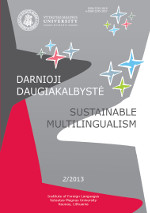Lietuvių kalbos dėstymo Jogailaičių universitete istorija ir dabartis
Teaching Lithuanian at Jagelonian University: History and Present
Author(s): Greta Lemanaitė-DepratiSubject(s): Foreign languages learning
Published by: Vytauto Didžiojo Universitetas
Keywords: Jagiellonian University; the Lithuanian language; Lithuanian language teaching methodology; the Lithuanian language for foreigners
Summary/Abstract: The aim of this study is to analyse the tradition of Lithuanian language teaching at Jagiellonian University and to discuss the current situation focusing, among other things, on the problems of methodology. Despite the fact that the Lithuanian language has been taught at Jagiellonian University for over a century, its teaching tradition and the current situation has never been thoroughly analysed. Moreover, Jagiellonian University must be the only institution of Higher education in Poland to teach Lithuanian almost uninterruptedly for a hundred years. Therefore, the present article also aims at commemorating this important anniversary by paying due tribute to people, the teachers and professors of the university, whose efforts helped to maintain Lithuanian at Jagiellonian University over this long period of time. From a historical perspective, this period of time was marked by rather complicated political relations between the states of Lithuania and Poland, especially at the beginning of the 20th century. For that reason, it was particularly difficult to preserve the course of the Lithuanian language at Jagiellonian University. In addition to historical perspective, the study aims at investigating the change in methodological and motivational aspects of teaching Lithuanian. Over this hundred-year period students’ motivation for studying Lithuanian has significantly changed. At the beginning it was a wish to learn more about an archaic language itself, which was almost on the verge of extinction but rich in its linguistic features and representing one of the two remaining Baltic languages, that motivated students to study it. In the later times, the Lithuanian language gained attractiveness as a language of a neighbouring, but still very unfamiliar country. The latter change was influenced by an altering situation in Europe as well as positive political changes in the relations between Poland and Lithuania. As far as methodology is concerned, the changes in methods were very much dependent on the changes in the teaching staff. In that regard, the hundred years can be divided into two periods: the first period lasting from the beginning to the last decade of the 20th century and the second period extending to the present days. The first period is marked by a constant change of teachers and the ensuing heterogeneity of teaching methods and learning outcomes. The second period is marked by more stability in the teaching process with the same teacher working for a longer time. Finally, a significant aspect of language learning that has been recently accentuated in the courses of Lithuanian at Jagiellonian University is the close interrelation between language and culture. Thus, the present study also examines the acquisition of linguistic competence in view of Lithuanian and Polish cultural differences.
Journal: Darnioji daugiakalbystė
- Issue Year: 2013
- Issue No: 2
- Page Range: 24-35
- Page Count: 12
- Language: Lithuanian

